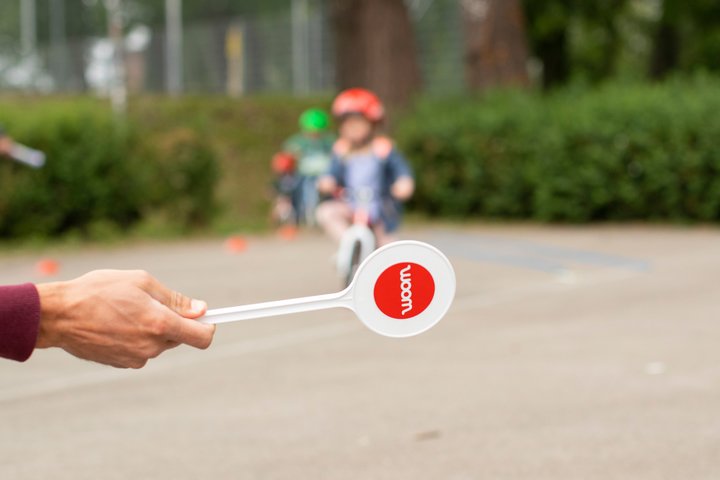So your child's motor skills are spot on and they happily zoom around the playground and garden on their bike? Brilliant news! That's a couple of boxes ticked ahead of them taking their bike out for a spin on the road.
That first family bike ride on the road is a big moment for you and your child. Your little one is going to have to coordinate lots of different movements and make the right move at the right time. You're going to all need to be well prepared to make sure that everyone stays safe. We've put together a handy guide for you so you know what's what...
Hardware: The bike and equipment are the first keys to safety.
- Adjust the saddle so that your child's feet comfortably touch the floor.
- Check the bike over on a regular basis. Make sure that all the screws are tight, the tyres are pumped up and the brakes and lights are in full working order.
- Never forget that all-important helmet! Head injuries are the most common complaint after a bike accident. The best thing you can do here is set a good example.
- Children are smaller than adults and will be seated in a lower position, so it's important that you make sure they are as visible as possible. In addition to the bike lights required by law, we also recommend you dress them in bright colours and attach safety reflectors to their helmet and clothing. It's also a good idea to have a bell, so that your child has an easy way of drawing attention to themselves if needed.
Rules of the road: The main road signs like stop and give way are easy to explain. Whatever you do, make sure your child is familiar with them.
Go through what they need to do in certain situations beforehand for an added layer of safety. It's best to practice in the safest place you can find and run through specific scenarios with your child on your bikes. Examples include:
- Giving clear hand signals when turning left and right
- Proceeding correctly at open junctions, i.e. braking in good time and coming to a stop
- Communicating with other road users by looking over your shoulder and making eye contact
- Dealing with tricky points along the route, i.e. avoiding obstacles and passing parked cars
You can always make things a bit more fun when practising...
- Precision braking should be par for the course. Try drawing a mark on the floor to show your child the point at which they need to have stopped.
- Ask your child to shout out "I'm looking left and right!" at every junction.
- One thing you can do to help your child to practice looking around and over their shoulder is to hold up a certain number of fingers as your child cycles past you. Get them to check how many fingers you are holding up and call it out to you.
- Switch positions with your child and let them watch you ride your bike. Deliberately make a mistake. Your child will be more than delighted to point it out to you.
The best thing to do is just keep repeating steps until your child has taken them on board and does them automatically. As they say, practice really does make perfect!
Right route: Choose an appropriate route beforehand and don't forget that the shortest route is not necessarily the best. A slight detour may be enough to make your bike ride safer and more relaxed. Especially if there is less traffic and fewer major junctions to cross. Pick a short or familiar journey, like the school run, as an introduction to riding a bike on the road with actual moving traffic. As an added bonus, this kind of activity in the morning will help your child to concentrate at school :)
Supervision: Who's leading the way?
- If you can, try to have two adults supervising your child for their very first bike rides on the road. Keep your child in the middle. This way, they can watch everything the person in front does and the person at the back can keep an eye on them at all times.
- You're sure to often find yourself cycling alone with your child too. In that case, it is best if your child cycles ahead of you if they know the route well. Stay as close as possible to your child at all times so you can keep them in your view and give them instructions in plenty of time. You may need to do this if there is an obstacle in the road, for example.
If you are cycling on unfamiliar or busy roads, however, we recommend that you go in front.
Never forget that you are setting an example. When children are faced with new situations, it is important that they have a role model to watch and copy. Don't just lecture your child about the rules of the road. Show them how to comply with them properly.
Remind yourself of the traffic regulations that apply in your country. And if you're based in the UK, it's a good idea to reread the Highway Code. Basically, you want the relevant legal provisions to be fresh in your memory, including the bike equipment and clothing you need. You should also find guidance on the age at which children can cycle on the road alone and/or which conditions apply.

.jpg?width=926&upsize=true&name=woom_still_and_moving_in_action_2018_345-Edit-720x480-32ef3212-c95f-4d63-b83a-d57bf7c038f6%20(1).jpg)
